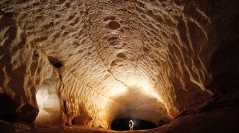

 Comptes Rendus Palevol
22 (15) - Pages 265-277
Comptes Rendus Palevol
22 (15) - Pages 265-277Saint-Marcel Cave, in the terminal part of the Ardèche Gorge, is a vast karstic network, and also a key Mousterian site close to the Rhône Valley. Numerous occupations dated between the last interglacial (MIS 5e) and the end of MIS 3/beginning of MIS 2 are well documented beneath the natural porch. Recently, two discoveries of Mousterian lithic industries in the entrance gallery, 150 and 500 m from the porch, have been uncovered. They attest to deep incursions by Neanderthals into very large galleries in the karst network, at considerable distances from the daylight zone. The association of these lithic industries with Pleistocene faunal assemblages, mainly from cave bear dens, suggests that Neanderthals exploited Ursidae. These discoveries thus provide new data for understanding how these hominids adapted their subsistence economy or symbolic practices to the underground environment. Neanderthal’s use and frequentation of karst networks has long been ignored due to the lack of incontrovertible evidence. The discovery of Neanderthal activity in the deep network of Bruniquel Cave (France) around –170 000 years ago shed new light on our perception of the relationship between these hominids and the underground world. The multiplication of examples of Neanderthal consumption activities and raw material exploitation (skin, bones) of large carnivores, and in particular bears, gives us fresh insights into the diversity of the behavior of these hominids and their organization. In Europe, many sites have yielded such evidence. The exploitation of large carnivores by Neanderthal thus seems much less marginal than it appeared until recently.
Middle Paleolithic, Neanderthal, evolution, behavior, explorations, endokarst, subsistence strategies